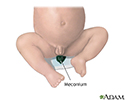Changes in the newborn at birth
Birth - changes in the newbornChanges in the newborn at birth refer to the changes an infant's body undergoes to adapt to life outside the womb.
-
Information
LUNGS, HEART, AND BLOOD VESSELS
The mother's placenta helps the baby "breathe" while it is growing in the womb. Oxygen and carbon dioxide flow through the blood in the placenta. Most of it goes to the heart and flows through the baby's body.
At birth, the baby's lungs are filled with fluid. They are not inflated. The baby takes the first breath within about 10 seconds after delivery. This breath sounds like a gasp, as the newborn's central nervous system reacts to the sudden change in temperature and environment.
Once the baby takes the first breath, a number of changes occur in the infant's lungs and circulatory system:
- Increased oxygen in the lungs causes a decrease in blood flow resistance to the lungs.
- Blood flow resistance of the baby's blood vessels also increases.
- Fluid drains or is absorbed from the respiratory system.
- The lungs inflate and begin working on their own, moving oxygen into the bloodstream and removing carbon dioxide by breathing out (exhalation).
BODY TEMPERATURE
A developing baby produces about twice as much heat as an adult. A small amount of heat is removed through the developing baby's skin, the amniotic fluid, and the uterine wall.
After delivery, the newborn begins to lose heat. Receptors on the baby's skin send messages to the brain that the baby's body is cold. The baby's body creates heat by burning stores of brown fat, a type of fat found only in fetuses and newborns. Newborns are rarely seen to shiver.
LIVER
In the baby, the liver acts as a storage site for sugar (glycogen) and iron. When the baby is born, the liver has various functions:
- It produces substances that help the blood to clot.
- It begins breaking down waste products such as excess red blood cells.
- It produces a protein that helps break down bilirubin. If the baby's body does not properly break down bilirubin, it can lead to newborn jaundice.
GASTROINTESTINAL TRACT
A baby's gastrointestinal system doesn't fully function until after birth.
In late pregnancy, the baby produces a tarry green or black waste substance called meconium. Meconium is the medical term for the newborn infant's first stools. Meconium is composed of amniotic fluid, mucus, lanugo (the fine hair that covers the baby's body), bile, and cells that have been shed from the skin and intestinal tract. In some cases, the baby passes stools (meconium) while still inside the uterus.
URINARY SYSTEM
The developing baby's kidneys begin producing urine by 9 to 12 weeks into the pregnancy. After birth, the newborn will usually urinate within the first 24 hours of life. The kidneys become able to maintain the body's fluid and electrolyte balance.
The rate at which blood filters through the kidneys (glomerular filtration rate) increases sharply after birth and in the first 2 weeks of life. Still, it takes some time for the kidneys to get up to speed. Newborns have less ability to remove excess salt (sodium) or to concentrate or dilute the urine compared to adults. This ability improves over time.
IMMUNE SYSTEM
The immune system begins to develop in the baby, and continues to mature through the child's first few years of life. The womb is a relatively sterile environment. But as soon as the baby is born, they are exposed to a variety of bacteria and other potential disease-causing substances. Although newborn infants are more vulnerable to infection, their immune system can respond to infectious organisms.
Newborns do carry some antibodies from their mother, which provide protection against infection. Breastfeeding also helps improve a newborn's immunity.
SKIN
Newborn skin will vary depending on the length of the pregnancy. Premature infants have thin, transparent skin. The skin of a full-term infant is thicker.
Characteristics of newborn skin:
- A fine hair called lanugo might cover the newborn's skin, especially in preterm babies. The hair should disappear within the first few weeks of the baby's life.
- A thick, waxy substance called vernix may cover the skin. This substance protects the baby while floating in amniotic fluid in the womb. Vernix should wash off during the baby's first bath.
- The skin might be cracking, peeling, or blotchy, but this should improve over time.
##RemoveMe##
References
Carlo WA.The newborn infant. In: Kliegman RM, Stanton BF, St. Geme JW, Schor NF, eds. Nelson Textbook of Pediatrics. 20th ed. Philadelphia, PA: Elsevier; 2016:chap 94.
Olsson JM. The newborn. In: Kliegman RM, Stanton BF, St. Geme JW, Schor NF, eds. Nelson Textbook of Pediatrics. 20th ed. Philadelphia, PA: Elsevier; 2016:chap 9.
Rozance PJ, Rosenberg AA. The neonate. In: Gabbe SG, Niebyl JR, Simpson JL, et al, eds. Obstetrics: Normal and Problem Pregnancies. 7th ed. Philadelphia, PA: Elsevier; 2017:chap 22.






